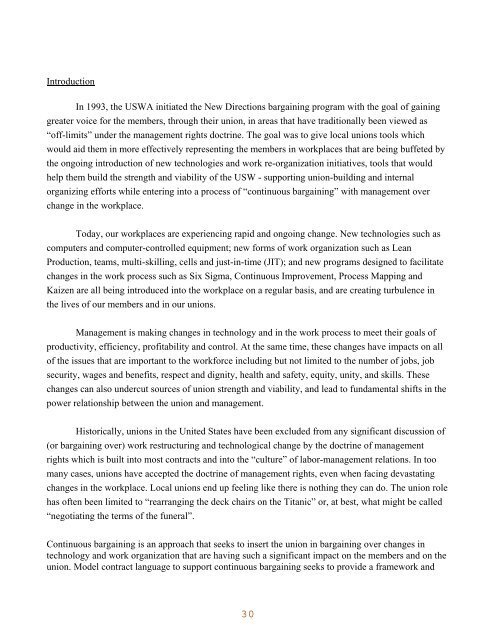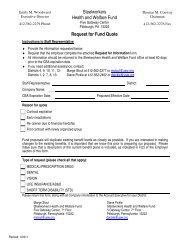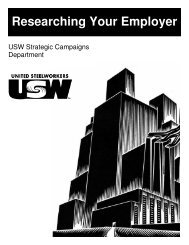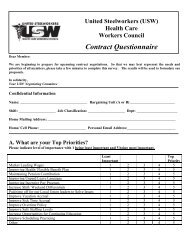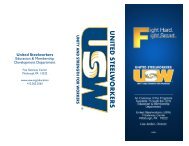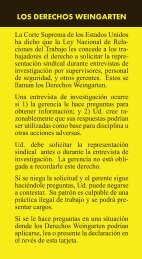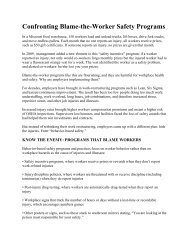Union Approach to Health and Safety: - United Steelworkers
Union Approach to Health and Safety: - United Steelworkers
Union Approach to Health and Safety: - United Steelworkers
Create successful ePaper yourself
Turn your PDF publications into a flip-book with our unique Google optimized e-Paper software.
Introduction<br />
In 1993, the USWA initiated the New Directions bargaining program with the goal of gaining<br />
greater voice for the members, through their union, in areas that have traditionally been viewed as<br />
“off-limits” under the management rights doctrine. The goal was <strong>to</strong> give local unions <strong>to</strong>ols which<br />
would aid them in more effectively representing the members in workplaces that are being buffeted by<br />
the ongoing introduction of new technologies <strong>and</strong> work re-organization initiatives, <strong>to</strong>ols that would<br />
help them build the strength <strong>and</strong> viability of the USW - supporting union-building <strong>and</strong> internal<br />
organizing efforts while entering in<strong>to</strong> a process of “continuous bargaining” with management over<br />
change in the workplace.<br />
Today, our workplaces are experiencing rapid <strong>and</strong> ongoing change. New technologies such as<br />
computers <strong>and</strong> computer-controlled equipment; new forms of work organization such as Lean<br />
Production, teams, multi-skilling, cells <strong>and</strong> just-in-time (JIT); <strong>and</strong> new programs designed <strong>to</strong> facilitate<br />
changes in the work process such as Six Sigma, Continuous Improvement, Process Mapping <strong>and</strong><br />
Kaizen are all being introduced in<strong>to</strong> the workplace on a regular basis, <strong>and</strong> are creating turbulence in<br />
the lives of our members <strong>and</strong> in our unions.<br />
Management is making changes in technology <strong>and</strong> in the work process <strong>to</strong> meet their goals of<br />
productivity, efficiency, profitability <strong>and</strong> control. At the same time, these changes have impacts on all<br />
of the issues that are important <strong>to</strong> the workforce including but not limited <strong>to</strong> the number of jobs, job<br />
security, wages <strong>and</strong> benefits, respect <strong>and</strong> dignity, health <strong>and</strong> safety, equity, unity, <strong>and</strong> skills. These<br />
changes can also undercut sources of union strength <strong>and</strong> viability, <strong>and</strong> lead <strong>to</strong> fundamental shifts in the<br />
power relationship between the union <strong>and</strong> management.<br />
His<strong>to</strong>rically, unions in the <strong>United</strong> States have been excluded from any significant discussion of<br />
(or bargaining over) work restructuring <strong>and</strong> technological change by the doctrine of management<br />
rights which is built in<strong>to</strong> most contracts <strong>and</strong> in<strong>to</strong> the “culture” of labor-management relations. In <strong>to</strong>o<br />
many cases, unions have accepted the doctrine of management rights, even when facing devastating<br />
changes in the workplace. Local unions end up feeling like there is nothing they can do. The union role<br />
has often been limited <strong>to</strong> “rearranging the deck chairs on the Titanic” or, at best, what might be called<br />
“negotiating the terms of the funeral”.<br />
Continuous bargaining is an approach that seeks <strong>to</strong> insert the union in bargaining over changes in<br />
technology <strong>and</strong> work organization that are having such a significant impact on the members <strong>and</strong> on the<br />
union. Model contract language <strong>to</strong> support continuous bargaining seeks <strong>to</strong> provide a framework <strong>and</strong>


